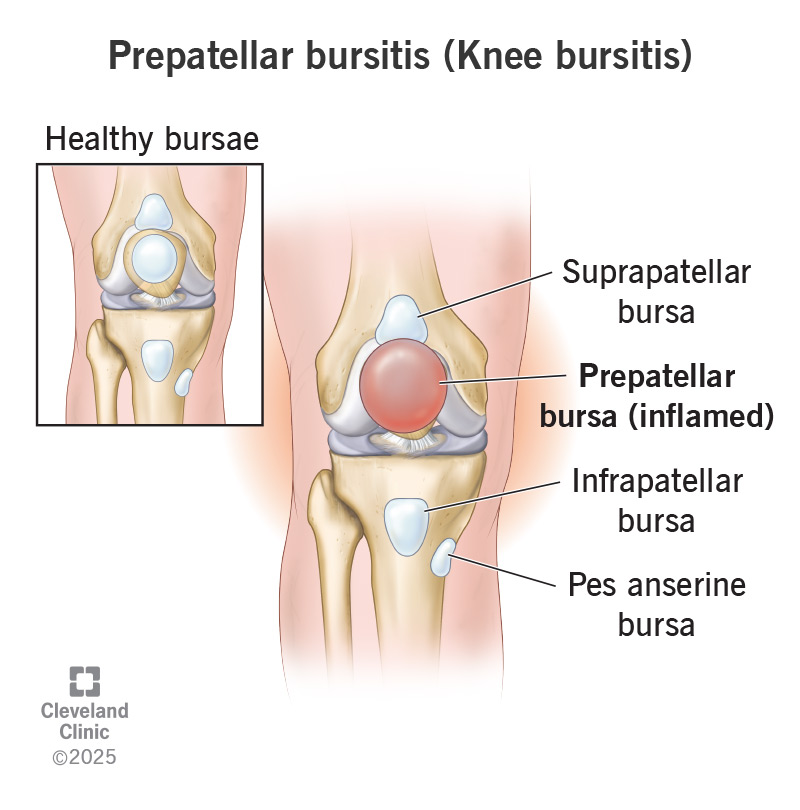Prepatellar bursitis is a common and treatable condition that causes the front of your knee to swell. It happens when the bursa sac in front of your kneecap becomes inflamed. You can treat most cases of prepatellar bursitis from home with rest, ice and elevation. But if your symptoms continue or you have an infection, see your healthcare provider.
Advertisement
Cleveland Clinic is a non-profit academic medical center. Advertising on our site helps support our mission. We do not endorse non-Cleveland Clinic products or services. Policy

Prepatellar bursitis is inflammation of the bursa (a fluid-filled sac) that’s located in front of your kneecap (patella). Knee bursitis happens when irritation, infection or damage affects the bursa and it makes too much fluid. The extra fluid causes the bursa to swell and puts pressure on other parts of your knee joint. You can usually see prepatellar bursitis because the front of your knee looks swollen.
Advertisement
Cleveland Clinic is a non-profit academic medical center. Advertising on our site helps support our mission. We do not endorse non-Cleveland Clinic products or services. Policy
Prepatellar bursitis is the second most common type of bursitis. Other names for the condition include:
There are two types of prepatellar bursitis:
Knee bursitis symptoms depend on the type you have and how severe it is. There are three general signs of prepatellar bursitis. But you don’t need to have all three to have the condition. The three signs are:
Advertisement
If an infection causes the knee bursitis, you’ll likely have additional symptoms, including:
If you’re experiencing symptoms of an infection, it’s important to contact your healthcare provider immediately or go to the nearest hospital. Infected prepatellar bursitis needs medical treatment. If left untreated, it can cause serious and life-threatening complications.
There are a few situations and conditions that can cause prepatellar bursitis, including:
Anyone can get prepatellar bursitis, but it most commonly affects people:
If left untreated, prepatellar bursitis that involves an infection can lead to severe complications like septic shock or even death. It’s essential to contact your healthcare provider immediately or go to the nearest hospital if you’re experiencing symptoms of an infection.
Your healthcare provider will ask you questions about your symptoms and medical history. Then, they’ll do a physical exam, focusing on your affected knee. They’ll check for pain, tenderness and the range of motion of your knee. Imaging tests can also help confirm a knee bursitis diagnosis or rule out other possible conditions.
Specific tests that providers can use to help diagnose prepatellar bursitis or rule out other possible conditions include:
Advertisement
Prepatellar bursitis treatment depends on the severity of the condition. You can treat most cases of prepatellar bursitis that just involve inflammation from home without medical intervention. If an infection is the cause of the prepatellar bursitis, you’ll need antibiotics to treat it.
Treatment for prepatellar bursitis that involves just an inflamed bursa may include:
Treatment for prepatellar bursitis that involves an infection may include:
Advertisement
If you’re experiencing a fever, chills and other signs of an infection, contact your healthcare provider right away or go to the nearest hospital. Prepatellar bursitis that involves an infection needs immediate medical treatment.
You can treat most cases of prepatellar bursitis from home with rest, ice, compression and elevation. The swelling and other symptoms usually go away in a couple of weeks, and you shouldn’t have any lasting side effects. If the prepatellar bursitis doesn’t get better after two to three weeks of rest, reach out to your healthcare provider.
Chronic knee bursitis may be more difficult to treat, especially if you have a job that requires frequent kneeling. Your healthcare team will come up with a treatment plan that works best for you and your situation. If left untreated, chronic prepatellar bursitis can last months or even years.
There are a few things you can do to prevent prepatellar bursitis, including:
Advertisement
Your knee is a hardworking joint. And you may not think about it much until you experience an issue with it. Prepatellar bursitis is a common condition that you can usually treat from home with rest, ice and elevation. But if your symptoms continue to affect your day-to-day life or don’t get better after a couple of weeks, reach out to your healthcare provider. They can determine a treatment plan that will work for your condition. If you’re experiencing symptoms of an infection, like a fever or warmth of the affected area, be sure to seek medical care as soon as possible.
Bursitis can make your hobby or your job a real pain. Cleveland Clinic experts can help you find relief and get you back to doing the things you love.

Last reviewed on 04/10/2025.
Learn more about the Health Library and our editorial process.